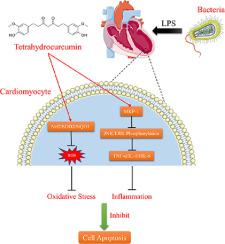Phytomedicine ( IF 7.9 ) Pub Date : 2022-06-18 , DOI: 10.1016/j.phymed.2022.154283 Hanzhao Zhu 1 , Liyun Zhang 1 , Hao Jia 2 , Lu Xu 3 , Yu Cao 3 , Mengen Zhai 1 , Kaifeng Li 4 , Lin Xia 5 , Liqing Jiang 1 , Xiang Li 1 , Yenong Zhou 1 , Jincheng Liu 1 , Shiqiang Yu 1 , Weixun Duan 1

|
Background
Acute myocardial dysfunction in patients with sepsis is attributed to oxidative stress, inflammation, and cardiomyocyte loss; however, specific drugs for its prevention are still lacking. Tetrahydrocurcumin (THC) has been proven to contribute to the prevention of various cardiovascular diseases by decreasing oxidative stress and inflammation. This study was performed to investigate the functions and mechanism of action of THC in septic cardiomyopathy.
Methods
After the oral administration of THC (120 mg/kg) for 5 consecutive days, a mouse model of sepsis was established via intraperitoneal lipopolysaccharide (LPS, 10 mg/kg) injection. Following this, cardiac function was assessed, pathological section staining was performed, and inflammatory markers were detected.
Results
Myocardial systolic function was severely compromised in parallel with the accumulation of reactive oxygen species and enhanced cardiomyocyte apoptosis in mice with sepsis. These adverse changes were markedly reversed in response to THC treatment in septic mice as well as in LPS-treated H9c2 cells. Mechanistically, THC inhibited the release of pro-inflammatory cytokines, including tumor necrosis factor alpha, interleukin (IL)-1β, and IL-6, by upregulating mitogen-activated protein kinase phosphatase 1, to block the phosphorylation of c-Jun N-terminal kinase (JNK) and extracellular signal-regulated protein kinase (ERK). Additionally, THC enhanced the levels of antioxidant proteins, including nuclear factor-erythroid 2-related factor 2, superoxide dismutase 2, and NAD(P)H quinone oxidoreductase 1, while decreasing gp91phox expression. Furthermore, upon THC treatment, Bcl-2 expression was significantly increased, along with a decline in Bax and cleaved caspase-3 expression, which reduced cardiomyocyte loss.
Conclusion
Our findings indicate that THC exhibited protective potential against septic cardiomyopathy by reducing oxidative stress and inflammation through the regulation of JNK/ERK signaling. The findings of this study provide a basis for the further evaluation of THC as a therapeutic agent against septic cardiomyopathy.
中文翻译:

四氢姜黄素通过 JNK/ERK 信号通路调节抑制氧化应激和炎症,改善脂多糖诱导的心肌功能障碍
背景
脓毒症患者的急性心肌功能障碍归因于氧化应激、炎症和心肌细胞丢失;然而,目前仍缺乏预防其的特效药物。四氢姜黄素 (THC) 已被证明可通过减少氧化应激和炎症来预防各种心血管疾病。本研究旨在探讨 THC 在败血症性心肌病中的作用和作用机制。
方法
连续5天口服THC(120 mg/kg)后,腹腔注射脂多糖(LPS,10 mg/kg)建立脓毒症小鼠模型。在此之后,评估心脏功能,进行病理切片染色,并检测炎症标志物。
结果
脓毒症小鼠的心肌收缩功能严重受损,同时活性氧的积累和心肌细胞凋亡增强。这些不利变化在脓毒症小鼠以及 LPS 处理的 H9c2 细胞中响应 THC 处理后显着逆转。从机制上讲,THC 通过上调有丝分裂原活化蛋白激酶磷酸酶 1 来抑制促炎细胞因子的释放,包括肿瘤坏死因子 α、白细胞介素 (IL)-1β 和 IL-6,从而阻断 c-Jun N-终末激酶 (JNK) 和细胞外信号调节蛋白激酶 (ERK)。此外,THC 提高了抗氧化蛋白的水平,包括核因子-红细胞 2 相关因子 2、超氧化物歧化酶 2 和 NAD(P)H 醌氧化还原酶 1,同时降低了 gp91 phox表达。此外,在 THC 处理后,Bcl-2 表达显着增加,同时 Bax 和裂解的 caspase-3 表达下降,从而减少心肌细胞损失。
结论
我们的研究结果表明,THC 通过调节 JNK/ERK 信号传导减少氧化应激和炎症,从而表现出对败血症性心肌病的保护作用。本研究的结果为进一步评估 THC 作为治疗败血症性心肌病的药物提供了基础。



























 京公网安备 11010802027423号
京公网安备 11010802027423号